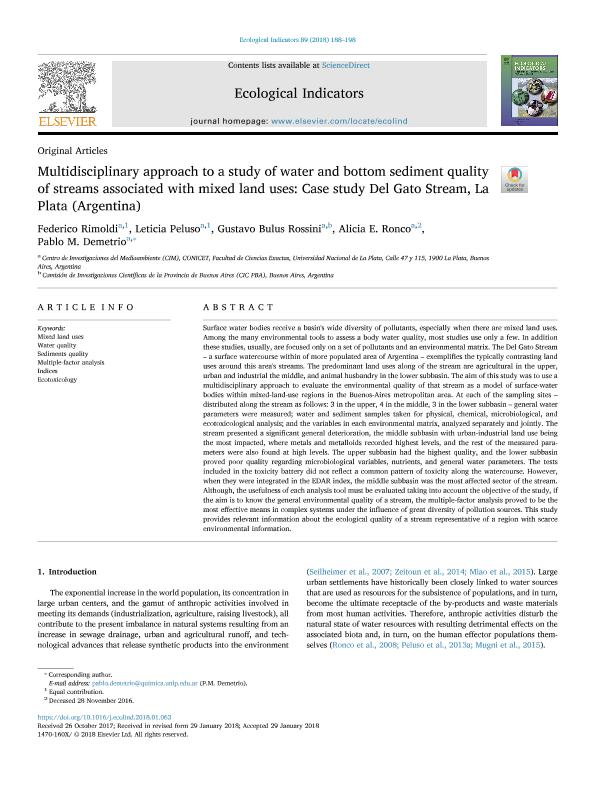Mostrar el registro sencillo del ítem
dc.contributor.author
Rimoldi, Federico

dc.contributor.author
Peluso, María Leticia

dc.contributor.author
Bulus Rossini, Gustavo Daniel

dc.contributor.author
Ronco, Alicia Estela

dc.contributor.author
Demetrio, Pablo Martin

dc.date.available
2019-10-08T15:56:50Z
dc.date.issued
2018-06
dc.identifier.citation
Rimoldi, Federico; Peluso, María Leticia; Bulus Rossini, Gustavo Daniel; Ronco, Alicia Estela; Demetrio, Pablo Martin; Multidisciplinary approach to a study of water and bottom sediment quality of streams associated with mixed land uses: Case study Del Gato Stream, La Plata (Argentina); Elsevier Science; Ecological Indicators; 89; 6-2018; 188-198
dc.identifier.issn
1470-160X
dc.identifier.uri
http://hdl.handle.net/11336/85331
dc.description.abstract
Surface water bodies receive a basin's wide diversity of pollutants, especially when there are mixed land uses. Among the many environmental tools to assess a body water quality, most studies use only a few. In addition these studies, usually, are focused only on a set of pollutants and an environmental matrix. The Del Gato Stream – a surface watercourse within of more populated area of Argentina – exemplifies the typically contrasting land uses around this area's streams. The predominant land uses along of the stream are agricultural in the upper, urban and industrial the middle, and animal husbandry in the lower subbasin. The aim of this study was to use a multidisciplinary approach to evaluate the environmental quality of that stream as a model of surface-water bodies within mixed-land-use regions in the Buenos-Aires metropolitan area. At each of the sampling sites – distributed along the stream as follows: 3 in the upper, 4 in the middle, 3 in the lower subbasin – general water parameters were measured; water and sediment samples taken for physical, chemical, microbiological, and ecotoxicological analysis; and the variables in each environmental matrix, analyzed separately and jointly. The stream presented a significant general deterioration, the middle subbasin with urban-industrial land use being the most impacted, where metals and metalloids recorded highest levels, and the rest of the measured parameters were also found at high levels. The upper subbasin had the highest quality, and the lower subbasin proved poor quality regarding microbiological variables, nutrients, and general water parameters. The tests included in the toxicity battery did not reflect a common pattern of toxicity along the watercourse. However, when they were integrated in the EDAR index, the middle subbasin was the most affected sector of the stream. Although, the usefulness of each analysis tool must be evaluated taking into account the objective of the study, if the aim is to know the general environmental quality of a stream, the multiple-factor analysis proved to be the most effective means in complex systems under the influence of great diversity of pollution sources. This study provides relevant information about the ecological quality of a stream representative of a region with scarce environmental information.
dc.format
application/pdf
dc.language.iso
eng
dc.publisher
Elsevier Science

dc.rights
info:eu-repo/semantics/openAccess
dc.rights.uri
https://creativecommons.org/licenses/by-nc-nd/2.5/ar/
dc.subject
ECOTOXICOLOGY
dc.subject
INDICES
dc.subject
MIXED LAND USES
dc.subject
MULTIPLE-FACTOR ANALYSIS
dc.subject
SEDIMENTS QUALITY
dc.subject
WATER QUALITY
dc.subject.classification
Ciencias Medioambientales

dc.subject.classification
Ciencias de la Tierra y relacionadas con el Medio Ambiente

dc.subject.classification
CIENCIAS NATURALES Y EXACTAS

dc.title
Multidisciplinary approach to a study of water and bottom sediment quality of streams associated with mixed land uses: Case study Del Gato Stream, La Plata (Argentina)
dc.type
info:eu-repo/semantics/article
dc.type
info:ar-repo/semantics/artículo
dc.type
info:eu-repo/semantics/publishedVersion
dc.date.updated
2019-09-27T14:33:10Z
dc.journal.volume
89
dc.journal.pagination
188-198
dc.journal.pais
Países Bajos

dc.journal.ciudad
Amsterdam
dc.description.fil
Fil: Rimoldi, Federico. Consejo Nacional de Investigaciones Científicas y Técnicas. Centro Científico Tecnológico Conicet - La Plata; Argentina. Universidad Nacional de La Plata. Facultad de Ciencias Exactas. Departamento de Química. Centro de Investigaciones del Medio Ambiente; Argentina
dc.description.fil
Fil: Peluso, María Leticia. Consejo Nacional de Investigaciones Científicas y Técnicas. Centro Científico Tecnológico Conicet - La Plata; Argentina. Universidad Nacional de La Plata. Facultad de Ciencias Exactas. Departamento de Química. Centro de Investigaciones del Medio Ambiente; Argentina
dc.description.fil
Fil: Bulus Rossini, Gustavo Daniel. Universidad Nacional de La Plata. Facultad de Ciencias Exactas. Departamento de Química. Centro de Investigaciones del Medio Ambiente; Argentina. Provincia de Buenos Aires. Gobernación. Comisión de Investigaciones Científicas; Argentina
dc.description.fil
Fil: Ronco, Alicia Estela. Consejo Nacional de Investigaciones Científicas y Técnicas. Centro Científico Tecnológico Conicet - La Plata; Argentina. Universidad Nacional de La Plata. Facultad de Ciencias Exactas. Departamento de Química. Centro de Investigaciones del Medio Ambiente; Argentina
dc.description.fil
Fil: Demetrio, Pablo Martin. Consejo Nacional de Investigaciones Científicas y Técnicas. Centro Científico Tecnológico Conicet - La Plata; Argentina. Universidad Nacional de La Plata. Facultad de Ciencias Exactas. Departamento de Química. Centro de Investigaciones del Medio Ambiente; Argentina
dc.journal.title
Ecological Indicators

dc.relation.alternativeid
info:eu-repo/semantics/altIdentifier/url/https://www.sciencedirect.com/science/article/pii/S1470160X18300700
dc.relation.alternativeid
info:eu-repo/semantics/altIdentifier/doi/http://dx.doi.org/10.1016/j.ecolind.2018.01.063
Archivos asociados
